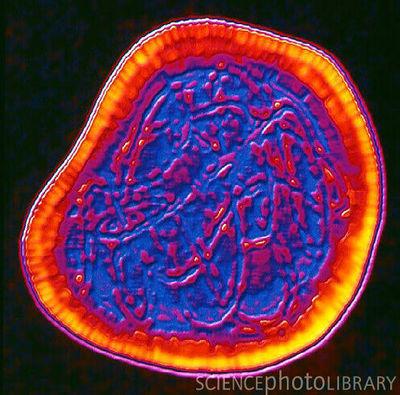Rubivirus: Difference between revisions
| Line 56: | Line 56: | ||
==Treatment== | ==Treatment== | ||
Treatment has not been found to be effective against postnatal rubella infection. Signs and symptoms may be treated with acetaminophen to reduce pain. The rubella virus yields mild symptoms in children and adults that do not present the need for medical attention. Pregnant women must watch for signs and symptoms and act upon them immediately. Hyperimmune globulin can be administered to women in order to lessen the side effects of the virus and lower the risk of the fetus being infected. (11) | |||
==Prevention== | ==Prevention== | ||
===Immunization=== | ===Immunization=== | ||
==Host Immune Response== | ==Host Immune Response== | ||
Revision as of 23:41, 25 July 2014
Etiology/Bacteriology
Taxonomy
| Domain = Viruses
| Class = ssRNA viruses
| Order = ssRNA positive-strand viruses, no DNA stage
| Family = Togaviridae
| Genus = Rubivirus
Description

Pathogenesis
Transmission
Rubella virus is transmitted through direct contact with respiratory fluid. (2) The virus initially infects the respiratory tract and begins the replication process in that location. (3) The virus is present in feces, blood, and nasopharyngeal mucous for up to seven days before signs of rash and up to seven days after signs of rash. The virus can still be spread person-to-person without signs of clinical infection. (8)
Infectious dose and Incubation Period
The Rubella virus is infective at a dose of 30 viral units injected under the skin, 10 viral units inhaled into the respiratory tract or 60 viral units via nasal drops. The incubation period for the virus is between 14 and 21 days. A rash will present approximately 14 days after infection. (10)
Epidemiology
Virulence Factors
E1 Protein
Clinical Features

From: http://classes.midlandstech.edu/carterp/courses/bio225/chap21/ss4.htm
Postnatal Infection
The rubella virus, when contracted postnatal, has very mild signs and symptoms. The disease begins with a rash that starts on the face, in most cases, and spreads to the rest of the body. In children, the disease will only cause the rash but in adults the rubivirus can cause mild fever, throat pain, arthralgia and enlarged lymph nodes, in addition to the rash. (3) The rubella virus causes a specific type of rash called maculopapular, meaning small flat, red and raised spots. (4) Overall, there is mild concern in regards to the Rubella infection when introduced into a healthy child or adult. In utero, infection of the Rubella virus causes severe birth defects or miscarriage in 80-90% of the patients. (8)
Congenital Syndrome
The Congenital Rubella Syndrome is contracted when the virus is engaged in utero within the first trimester of pregnancy. (8) The fetus is therefore infected by the virus. The pregnancy will either be miscarried or the baby will be born with developmental delays or defects. The severity of the complications depends upon the gestational age of the fetus at the time of infection. The gestational age of the fetus will also determine the organ system of the baby in which the virus attacks. The gestational age coincides with the developmental stage in which the fetus is going through. (3) The possible and most common birth defects include hearing loss, ductus arteriosis, psychomotor retardation, mental retardation, microcephaly, cataracts, glaucoma, retinopathy, microphthalmia, intrauterine growth retardation, thrombocytopenia purpura, hepatomegaly and splenomegaly. The baby will then still be infected after birth and can spread the viral infection for up to one year. A risk of other health complications can continue to develop as the baby progresses into childhood and even adulthood including diabetes mellitus, thyroid disfunction, growth hormone deficiency and vision problems. (3)
Diagnosis
Rubella virus can be diagnosed clinically via the presence of the rash and swollen lymph nodes. Further serological tests can be ran to determine the presence of certain IgM antibodies which indicate that the patient had been recently infected with the virus. Hemagglutinin inhibition, ELISA, and indirect immunofluorescent immunoassay can all be ran on a blood sample to determine the presence of the antibodies. In adults and children, the virus can be isolated from the mucous of the respiratory tract. In babies and children, the virus can be isolated from the mucous of the respiratory tract, urine, feces, and blood. The cultured samples can be tested for the presence of the virus via immunoperoxidase staining assay or virus interference. (1)
Treatment
Treatment has not been found to be effective against postnatal rubella infection. Signs and symptoms may be treated with acetaminophen to reduce pain. The rubella virus yields mild symptoms in children and adults that do not present the need for medical attention. Pregnant women must watch for signs and symptoms and act upon them immediately. Hyperimmune globulin can be administered to women in order to lessen the side effects of the virus and lower the risk of the fetus being infected. (11)
![University of Oklahoma Study Abroad Microbiology in Arezzo, Italy[1]](/images/7/7c/OULOGOBIANCO.JPEG)
